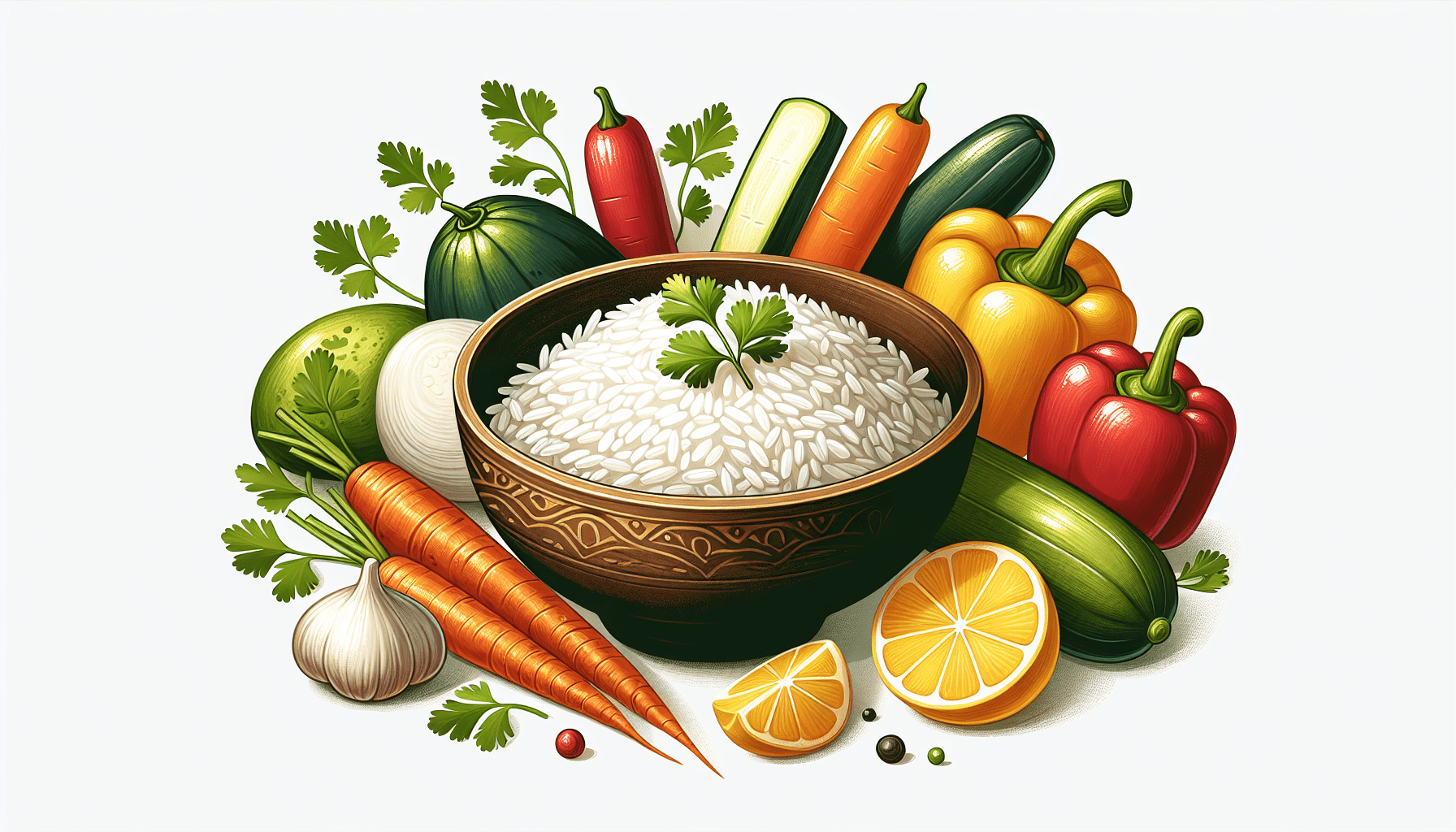Imagine discovering a diet that not only helps you shed those stubborn pounds but also promotes a host of other health benefits. Enter the Rice Diet – a simple and effective way to boost your wellbeing and achieve your weight loss goals. This article explores the numerous advantages of incorporating rice into your daily meals, from enhancing digestion to improving heart health and increasing energy levels. So, get ready to embark on a journey towards a healthier, fitter you with the incredible benefits of the Rice Diet.
Introduction to the Rice Diet
Welcome to the world of the Rice Diet, a nutritional approach that has gained popularity for its health benefits. In this article, we will explore the various aspects of this diet, including its nutritional value, weight loss benefits, digestion improvements, management of diabetes, impact on blood pressure and heart health, energy provision, gluten-free option, and affordability and accessibility. So, let’s dive in and discover the amazing advantages of incorporating rice into your diet!
Overview of the Rice Diet
The Rice Diet is a dietary plan centered around the consumption of rice as the primary source of carbohydrates. It promotes the inclusion of fruits, vegetables, lean proteins, and healthy fats, while restricting the intake of processed foods, added sugars, and fatty meats. The primary goal of this diet is to facilitate weight loss, improve digestion, manage diabetes, lower blood pressure, promote heart health, provide sustained energy, offer a gluten-free option, and be an affordable and accessible choice for individuals from various walks of life.
History of the Rice Diet
The Rice Diet has a rich history that dates back to the early 1930s, when it was developed by Dr. Walter Kempner at Duke University. Originally designed as a method to manage hypertension and kidney disease, the diet gained traction for its significant weight loss results. Over the years, the Rice Diet has evolved and gained popularity as an effective way to improve overall health and well-being.
Nutritional Value of Rice
Rice is a nutritional powerhouse, providing a range of essential macronutrients and micronutrients that are vital for the proper functioning of the body.
Macronutrients in Rice
Rice is a great source of carbohydrates, which serve as the body’s main source of energy. It also contains a moderate amount of protein, necessary for muscle repair and growth. Furthermore, rice is very low in fat, making it a suitable option for those seeking to manage their weight.
Micronutrients in Rice
Aside from its macronutrient content, rice is also rich in micronutrients like vitamins and minerals. It contains various B vitamins, including thiamine, niacin, and folate, which play a crucial role in energy metabolism and nerve function. Additionally, rice provides minerals like iron and magnesium, essential for red blood cell production and maintaining a healthy immune system.
Glycemic Index of Rice
The glycemic index (GI) is a measure of how quickly a food raises blood sugar levels. Rice, especially varieties like basmati and jasmine, has a relatively low glycemic index, making it a favorable choice for individuals with diabetes or those looking to manage their blood sugar levels.
Weight Loss Benefits
The Rice Diet has gained popularity as an effective weight loss strategy, primarily due to several factors that contribute to its success.
Caloric Restriction with Rice Diet
The Rice Diet promotes a caloric restriction by focusing on low-calorie, nutrient-dense foods. The high water and fiber content in rice help create a feeling of fullness, reducing the tendency to overeat and promoting weight loss.
High Fiber Content
Rice, particularly brown rice, is an excellent source of dietary fiber. Fiber adds bulk to the diet, promoting satiety, regulating bowel movements, and aiding in weight management.
Low in Fat
As mentioned earlier, rice is inherently low in fat. By incorporating rice into your diet, you can reduce your overall fat intake and promote weight loss.
Antioxidant Properties
While the Rice Diet primarily revolves around rice consumption, it also encourages the inclusion of antioxidant-rich fruits and vegetables. Antioxidants help combat oxidative stress, reducing inflammation and supporting overall health.
Improves Digestion
The Rice Diet provides numerous benefits for improving digestion, thanks to its high fiber content and other digestive-friendly properties.
High Fiber Content
As mentioned earlier, rice is an excellent source of dietary fiber. This high fiber content aids in digestion by promoting regular bowel movements, preventing constipation, and maintaining a healthy gut.
Relieves Constipation
Due to its fiber content, incorporating rice into your diet can help relieve constipation and promote regularity. It adds bulk to the stool, making it easier to pass through the digestive tract.
Promotes Gut Health
The fiber in rice acts as a prebiotic, which means it provides nourishment for beneficial gut bacteria. A healthy gut microbiome is essential for proper digestion, nutrient absorption, and overall well-being.
Manages Diabetes
For individuals with diabetes or those at risk of developing the condition, the Rice Diet offers several benefits for managing blood sugar levels and increasing insulin sensitivity.
Low Glycemic Index
Rice, particularly varieties like basmati and jasmine, has a low glycemic index, which means it causes a slower and more gradual rise in blood sugar levels. This makes it a suitable choice for individuals with diabetes, helping them better manage their blood glucose levels.
Regulates Blood Sugar Levels
The combination of low glycemic index and fiber content in rice helps regulate blood sugar levels, preventing rapid spikes and crashes. Consistent blood sugar levels are crucial for overall health and diabetes management.
Increases Insulin Sensitivity
Evidence suggests that incorporating rice into your diet can enhance insulin sensitivity, allowing the body to utilize insulin more efficiently. This can be particularly beneficial for individuals with diabetes or those at risk of developing the condition.
Lowers Blood Pressure
The Rice Diet has been shown to have a positive impact on blood pressure, making it a valuable dietary approach for individuals with hypertension.
Low in Sodium
The Rice Diet promotes a low-sodium eating pattern, which is essential for maintaining healthy blood pressure levels. Reducing sodium intake helps prevent water retention, lowers the strain on the cardiovascular system, and supports overall heart health.
High in Potassium
Rice, especially brown rice, is naturally high in potassium. Potassium is a mineral that helps balance sodium levels in the body, promoting healthy blood pressure. By incorporating rice into your diet, you can increase your potassium intake and help manage hypertension.
Reduces Water Retention
High sodium intake can lead to water retention in the body, putting extra strain on the cardiovascular system. By following the Rice Diet, which includes low-sodium foods like rice, you can reduce water retention and improve blood pressure levels.
Heart Health Benefits
A heart-healthy diet is a cornerstone of the Rice Diet, offering multiple advantages for cardiovascular health and reducing the risk of heart disease.
Reduces Bad Cholesterol
The Rice Diet focuses on the consumption of whole grains like brown rice, which are rich in dietary fiber. This fiber helps reduce the levels of LDL (bad) cholesterol in the blood, promoting a healthier lipid profile and reducing the risk of heart disease.
Lowers Risk of Heart Disease
The combination of a low-fat, low-sodium, high-fiber diet, as seen in the Rice Diet, has been associated with a decreased risk of heart disease. By following this dietary approach, you can support a healthy heart and reduce the likelihood of cardiovascular complications.
Contains Antioxidants
In addition to its benefits for cholesterol and blood pressure, the Rice Diet also encourages the inclusion of fruits and vegetables, which are excellent sources of antioxidants. Antioxidants help protect the heart from oxidative stress, reducing the risk of cardiovascular diseases.
Provides Energy
The Rice Diet is designed to provide sustained energy throughout the day, thanks to its focus on complex carbohydrates and balanced meals.
Complex Carbohydrates
Rice, especially brown rice, is a complex carbohydrate that provides a slow and steady release of energy. Unlike simple carbohydrates, which can cause rapid spikes and crashes in blood sugar levels, complex carbohydrates provide a sustained source of energy.
Sustained Energy Release
By including rice in your diet, you can avoid sudden energy crashes and maintain a steady level of energy throughout the day. This can enhance productivity, aid in physical activity, and support overall well-being.
Gluten-Free Option
For individuals with celiac disease or gluten sensitivity, the Rice Diet offers a gluten-free alternative to wheat-based grains.
Suitable for Celiac Disease
Rice is naturally gluten-free, making it a safe and suitable choice for individuals with celiac disease. By following the Rice Diet, individuals with celiac disease can enjoy a varied and nutritious diet while avoiding gluten-containing grains.
Alternative to Wheat-Based Grains
In addition to its suitability for celiac disease, the Rice Diet offers a versatile alternative to wheat-based grains for individuals seeking to reduce their gluten intake or explore different culinary options. Many rice varieties can be used in a wide array of dishes, making them a great swap for traditional wheat-based grains.
Affordability and Accessibility
The Rice Diet is not only a healthy choice but also an affordable and accessible one, making it suitable for individuals from various economic backgrounds.
Inexpensive Staple Food
Rice is a relatively inexpensive staple food, widely available in many parts of the world. Its affordability makes it a great option for individuals on a tight budget, ensuring that everyone can benefit from the advantages of the Rice Diet.
Widely Available
Rice is one of the most widely consumed grains globally, making it easily accessible in most supermarkets and markets. This accessibility ensures that individuals from various regions can incorporate rice into their diets and reap its health benefits.
Versatile in Cooking
Another advantage of rice is its versatility in cooking. It can be prepared in numerous ways, allowing for a wide range of dishes and flavors. From savory stir-fries to comforting rice bowls and delicious pilafs, the possibilities are endless with rice, making it an adaptable choice for any taste preference.
In conclusion, the Rice Diet offers a multitude of advantages for individuals seeking to improve their health and overall well-being. From its weight loss benefits and digestion improvements to its management of diabetes and heart health benefits, incorporating rice into your diet can be a transformative step towards a healthier lifestyle. Add to that its energy-providing qualities, gluten-free option, and affordability and accessibility, and you have a dietary approach that is both practical and beneficial. So why not explore the benefits of the Rice Diet and embark on a journey towards a healthier you!

